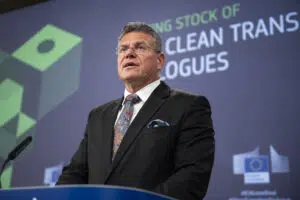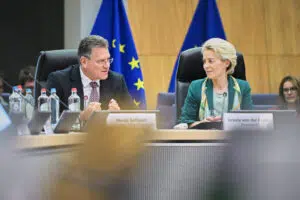Brussels – After legislation, it’s time for implementation. In a communication that takes stock of the nine clean transition dialogues conducted so far with European industry and social partners in recent months, the European Commission outlines the directions “that could support a strengthened industrial approach to deliver on the European Green Deal.” It starts preparing guidelines for implementation policies to achieve the 2050 climate goals, also building on the discussion scheduled at the April 17-18 Extraordinary European Council “on the next steps for Europe’s clean transition.”

the European Commission’s Executive Vice President for the Green Deal, Maroš Šefčovič, presented the outcome of the first round of dialogues with the European industry started in October 2023 and concluded on Monday (April 8) with representatives of the transport sector and made it clear how “our goals of decarbonization, green growth and European competitiveness go hand in hand” and at the same time “we need a strengthened industrial approach that ensures predictability for investors.” Hence, the five pillars on which action to implement Green Deal legislation should be set: an “effective and simplified” regulatory framework for businesses to make the transition, action on energy prices, “modern” infrastructure, “easier” access to finance, and a “stronger” Single Market in a globally competitive environment.
From hydrogen to critical raw materials, from clean technologies to energy infrastructure to forest-based bioeconomy, energy-intensive industries, cities, clean mobility, and steel. The nine dialogues staged over the past six months are just the beginning of a path on which the Commission “will continue to engage with industry and social partners, with a parallel “in-depth debate” with the Council and Parliament “on the key factors that need to be addressed.” The goal is to define the EU strategic agenda 2024-2029 for the next policy cycle, whose discussions among the 27 EU leaders will begin at next week’s extraordinary summit and should converge at the June European Council (when adoption is expected).
The five pillars for clean industrial transition

First and foremost, “the focus now shifts to implementation” of the Green Deal, and the European Commission will “provide further guidance to support industry and member states in the implementation of EU legislation and strengthen the focus on burden reduction.” To monitor and measure progress on clean transition and economic competitiveness, the Berlaymont services will publish “a set of key indicators” on a dedicated platform. On the clean energy and affordability front, the EU executive recalls that “Member States must take steps to eliminate fossil fuel subsidies” and “should make full use of the updated legal framework, in particular the Renewable Energy Directive, to ensure that the benefits of the clean transition go to industry and citizens.” The call for “industrial clusters linking the largest plants and manufacturing hubs with zero- and low-carbon generation facilities” comes from the same industries involved in the clean transition dialogues: “They have also called for reconsidering the level of taxes and fees on energy, including electricity.”
Then there is the issue of “modern infrastructure as the backbone” of European industry, which will require the Commission to consider “supporting industry in developing a standardization of demand for the cables, pipelines, and technologies needed for the development of the energy grid,” including through an ad hoc platform to tighten coordination with member states, local and regional authorities, grid operators, industrial players, regulators, and financial institutions on the development of infrastructure for the clean energy transition. The fourth pillar aims to unlock funding for the clean transition, particularly private funding that “has not yet been mobilized sufficiently”. For the von der Leyen cabinet, a “strong EU budget to deliver higher quality investments” is crucial, with “rapid progress” on both the use of public funds to raise private investment and the Emissions Trading Scheme (ETS). Finally, the leverage of the Single Market, “the EU’s greatest strength,” for which a pilot project for hydrogen and joint procurement of critical raw materials could be organized “based on the positive results of joint gas procurement,” the EU Commission writes.
English version by the Translation Service of Withub





